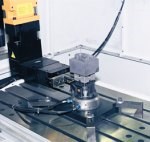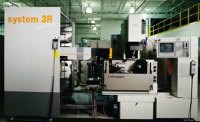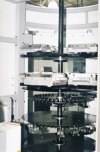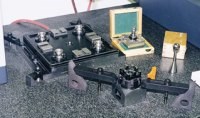Robots Join EDM and Graphite Mill for Fast Mold Production
An EDM plus a robot makes a dynamic duo. A graphite mill plus a robot makes another. Put them all together in one shop and you have a radical new way to speed mold production.
Share





Eighteen weeks. Sixteen weeks. Twelve weeks. The time it should take to build a mold keeps dropping and dropping. That means greater and greater pressure on mold shops to perform every step of the mold building process in less and less time and to perform as many steps as possible at the same time.
At Dynamic Tool & Design Inc. in Menomonee Falls, a suburb of Milwaukee, Wisconsin, this situation has long been the normal one. This shop was founded on the premise that aggressively seeking out the latest technology was the key to speed and efficiency in mold production. In 1976, founders Irv Fischer and John Lau started out with one piece of CNC equipment. At the time, CNC equipment was still rare in mold shops. The two toolmakers could see how CNC had untapped potential for streamlining mold production. It wasn't long before the fledgling shop was building quality molds and likewise building a reputation for reliable, on-time delivery.
Welcome! You’ve unlocked premium content.
Since then, this mold shop has consistently been the first, or one of the first, of its kind in the region, or even in the nation, to adopt new technology developments. For example, it was one of the first shops to install a ram EDM with CNC. It had an automatic toolchanger on an EDM before almost any other shop. It was one of the first mold shops to acquire a wire EDM unit. Along the way, the shop grew steadily, moving to larger facilities several times while adding more equipment and skilled personnel (it has around 75 employees and 22 CNC machines today).
The latest "first" for Dynamic Tool is a venture into robotics. In January, 1998, the shop ordered not one, but two, robotic systems. One is now installed on the shop's newest ram EDM. The robot automatically loads and unloads electrodes as well as pallets of workpieces to be EDMed. This robot-equipped EDM is one of the first such automated setups in a mold shop in this part of the country.
The second robot is installed on its newest graphite mill. This machine is the first one to be so equipped anywhere. The robot automatically loads and unloads premounted electrodes for machining in the high speed/high accuracy mode.
Today, both robot-equipped machine tools are running virtually around the clock. This level of automation is helping the company reduce lead times on the high-precision, multi-cavity plastic injection molds that are its specialty. According to Irv Fischer, Dynamic Tool's vice president, the time saved is already being measured in entire weeks.
But it's not just robotics that is contributing to the shop's campaign to shorten the delivery cycle. Almost everything the shop does is constantly being scrutinized to find ways to take out delays and eliminate downtime.
Fast Electrodes
Dynamic Tool's roboticized graphite mill consists of a BostoMatic Model 32GS Graphite Machining System from Boston Digital (Milford, Massachusetts) linked with a WorkMan robot and carousel from System 3R USA (Totowa, New Jersey). A similar WorkMan robot is linked to the shop's new ram EDM as well.
Although many BostoMatics have been installed in automated or roboticized cells, Dynamic Tool's new machine is the first of this particular model to be interfaced with a WorkMan robot. The robot builder installed a programmable access hatch on the side of the machine's enclosure to allow the robot's transfer arm to enter and exit the work area yet maintain the machine's pressurized dust control system. See Figure 1.
Interfacing the BostoMatic CNC with the robot controller was accomplished with software that is stored on the CNC's hard disk drive as a simple G-code based macro that can be called up through other G-code part programs. Boston Digital has used this approach to interface its CNCs with auxiliary devices because no modifications to the programmable logic controller or CNC base code are required. In this case, the robot controller and CNC communicate through a cable connected to standard serial ports on each device.
The prominent feature of this graphite mill is its high speed, high accuracy contouring capability. It is designed for feed rates of 400 ipm (787-ipm rapid traverse) with a CNC that processes tool path data at 1,100 blocks per second. However, high feed rates are less important in this application than how quickly the machine accelerates and decelerates from move to move, while maintaining positioning accuracies of ±0.0001 inch. The 25,000-rpm spindle allows diamond coated cutting tools to achieve the surface speeds required for minimal wear and good surface finish on the workpiece.
This graphite mill also features a CNC-based thermal compensation system that actively corrects for thermal growth in the spindle. Axis positions are automatically adjusted according to a software model of expected growth due to heat, which is minimized by a built-in temperature control system. In addition, Dynamic Tool took the Contour Optimization option for this machine. This software feature allows the shop to set the desired form tolerance and have the CNC automatically manage axis feed rates to ensure that deviation from the specified contour stays within the tolerance. The machine has 0.5 micron glass scales.
The robotic system features a multi-axis robotic changer with transfer arm that accesses a storage carousel to retrieve electrodes and deliver them to the precision workholding fixture mounted on the table of the graphite mill. The shop has had as many 150 electrodes in the carousel at one time with room to spare (220 electrodes is the maximum it will hold). See Figure 2.
In operation, the robot's function is to remove a finished electrode and replace it with the blank electrode identified by the control software as the next to be machined. The graphite mill machines one electrode at a time. As long as the robot has a new electrode waiting in the carousel, it can keep the graphite mill busy around the clock. And this extended unattended machining capability is precisely the point of the automation.
In fact, since the machine and robot were installed in September, 1998, they have been in continuous operation three shifts a day, seven days a week. At last report (early January, 1999), the duo had logged more than 60 days of non-stop, round-the-clock operation.
Getting Radical
As Mr. Fischer points out, this approach to electrode production represents a rather radical departure from the shop's previous approach. Formerly, two vertical machining centers were dedicated to "cutting carbon." Each of these CNC machines has extra wide tables so that two or more pallets holding multiple electrodes could be processed at one time. Palletizing workpieces allowed the machines to run overnight in the unattended mode. Although these machines were quite productive, they faced several limitations.
The number of electrodes that could be accommodated in the pallets determined how long the machines could run unattended. Loading and unloading the pallets involved lengthy setup routines with dial indicators to ensure the location of each electrode workpiece for precision machining. Using pallets complicated programming because it was necessary to make sure the right sequence of contouring programs was downloaded to the CNC. (The shop had written its own software to link location data with the corresponding workpiece and tool path program for sequential machining without operator intervention). According to Mr. Fischer, the shop required about four hours for setup and about three hours to program a sufficient number of electrodes to run these machines unattended overnight.
Finally, palletizing introduced a measure of inflexibility when it came to adjusting for shifting priorities in job scheduling. It was highly impractical to make last minute changes to the lineup of electrodes to be machined.
The machines themselves were limited. Feed rates topped out at 100 ipm, and contouring speed was restricted by the processing speeds of the CNC. Surface finishes did not always allow benching or grinding to be eliminated. Dust was controlled only by flooding graphite workpieces with coolant. Now that the high speed graphite mill is in place, both of these machines are no longer needed for electrode milling, so they have been reassigned to steel-cutting operations.
"Without a doubt, the biggest benefit is completing electrodes in far less time," Mr. Fischer attests. "We needed three days lead time in the past but now need a half a day or less to get a finished electrode to the EDM."
Key Elements
Mr. Fischer attributes this time savings to several key elements. The new machine is fast. It simply takes less time to complete the machining of a detailed electrode. Small stepovers and high feed rates produce surface finishes superior to grinding on complex contours and details—the finished electrodes are "ready to burn" right off the machine. There is no setup time between electrodes.
Whereas the shop used to grind its own graphite blanks from bulk stock and mount them on the standard 20-mm shanks most EDM shops are familiar with, Dynamic Tool now purchases premachined, premounted blanks. The premounted electrodes are more expensive, but savings in reduced in-house grinding and mounting operations, Mr. Fischer reports, offset the added cost. "Best of all, we've freed up our grinders and skilled grinding operators to concentrate on more challenging jobs," he says.
The electrodes are premounted on one of two compatible styles of precision holders from System 3R's MacroCombi system, depending on size. Figure 3 shows both types of holders. A precision air-operated chuck attached to the table of the mill receives both holders and provides precise, highly repeatable locations of each electrode (Figure 4). Clamping force is applied or released automatically.
Locating electrodes precisely and repeatably is essential here because it makes it unnecessary to use dial indicators to locate and orient the electrode. As soon as the robot transfer arm sets the holder into the chuck, the electrode is ready to be machined. There is no setup time associated with this step. For inspection purposes, an identical chuck has been set up on the bed of the shop's coordinate measuring machine, which is located in a climate-controlled room adjacent to the machining area on the shop floor.
It should be noted here that the quill of the ram EDM has the same style chuck as on the mill, so electrodes can be moved directly to the robotic carousel at the EDM. An electrode will not lose its reference as it moves from station to station. Electrode-to-electrode centering and location are critical for the multi-cavity molds that are the shop's specialty, because each cavity typically requires multiple electrodes.
Unattended Electrical Discharge Machining
About forty feet across the shop floor sits the other WorkMan system, where it is interfaced to a Mitsubishi VX10 ram EDM from MC Machinery Systems (Wood Dale, Illinois). See Figure 5. Typically, Dynamic Tool EDMs the cavities of mold inserts on this CNC "sinker." The VX10 is a mid-sized machine with a 700 by 500 mm (27.5 by 19.7 inch) table. The WorkMan robotic system here is very similar to the one at the graphite mill. However, it is configured to hold electrodes and workpiece pallets in its magazine. The transfer arm on this second system is equipped with a different style of gripper, one with wide forks to load and unload workpiece pallets by lifting them from below.
This capability greatly expands the EDM's native capacity for unattended operation. The VX10 has several notable features that lend themselves to unattended operation and efficient metal removal. The FP (Fine Pulse) power supply is designed to minimize the effects of secondary discharges, which tend to destabilize machining of complex surfaces and slow down the process. Likewise, the MF Fuzzy Logic control system is designed to automatically adjust machining parameters as conditions "in the burn" change due to variations in surface area occurring on contoured electrodes.
Another important feature is the orbiting capability of this model. Orbiting moves the electrode in a pattern that matches the periphery of a contour to create an overburn equal on all sides. By adjusting the orbital motion of an electrode, three electrodes of identical shape and size can be used for roughing, semi-roughing, and finishing. (The orbiting pattern "grows" from roughing to finishing as the overburn approaches final size.)
Together, the advanced control, power supply, and orbiting capability ensure that electrical discharge machining will proceed successfully without operator intervention. The robotic system allows one operation to commence after another to complete a mold cavity and then start over with another workpiece in the pallet. When all work on the pallet is completed, another pallet can be exchanged in its place. The only limit to unattended operation is the capacity of the robotic carousel, but the carousel can be continually restocked as new electrodes are completed. See Figure 6.
Workpieces are mounted on System 3R Dynafix pallets, which are compatible with the chucks and reference system of the MacroCombi integrated workholding system. The Dynafix pallets are roughly 12 inches square and the WorkMan transfer arm can handle loaded pallets weighing up to 165 lbs. At Dynamic, several mold inserts are set up on a pallet for electrical discharge machining at one time, although a partially completed batch could be removed and returned for restarting at a later time to suit scheduling priorities.
Pallets are set up off-line. A table chuck identical to the one in the EDM is located on the CMM (Figure 7). Locations and reference points are established on the CMM, thus eliminating the need to find workpiece position at the EDM. The data from the CMM are downloaded to the EDM when the pallet is loaded into the EDM. This approach minimizes downtime.
Burn Strategy
Palletizing workpieces has changed some of the shop's production methods. In the past, the shop would often EDM as many as 12 mold cavities in a single piece of steel, then use wire EDM to cut the steel into separate insert blocks, each with its own cavity. This approach minimized the number of electrodes that were required for producing multi-cavity molds. One electrode could be used to rough-burn several cavities, followed by a semi-roughing operation that also reused electrodes.
The new workpiece pallets, however, are considerably smaller than the worktable of the EDM. Now, the shop finds that the most effective strategy is to complete cavities in smaller groups. This approach allows each pallet to be completed at one time and then returned to the carousel.
Although more electrodes need to be produced, the efficiencies of high speed machining keep this from becoming a burden. The advantage is faster throughput in producing the cavities.
Comfortable with Automation
Introducing not one but two robotic systems at one time in a shop could have created quite a strain on any shop's workforce, but it was taken in stride at Dynamic Tool. One reason is that the company has a long history of keeping its people well-trained and engaged in technology issues.
Before either robotic system arrived, everyone involved participated in the planning and preparation for them. Not only were their questions and concerns addressed, but also their ideas and suggestions were solicited. With the systems now in place, both the approval and the enthusiasm of the shop force supports the new operation.
One of the disadvantages to being leaders in the early adoption of emerging technology is having to learn as you go. Although the management team at Dynamic visited other users of the WorkMan robots around the country, the team knew some problems and opportunities could not be anticipated. Having a skilled and flexible corps of employees to deal with the unexpected is the best resource under these circumstances.
Setting The Pace
The initial success of its first two robotic applications has Mr. Fischer and Mr. Lau looking at additional systems to automate the shop's wire EDM operations. The shop's wire machines could be interfaced readily to robotic loaders and unloaders, such as System 3R's WorkPal, similar to the two robotic systems already installed at Dynamic Tool.
But automation is not an end in itself. What counts is how automation enhances a shop's ability to deliver the highest quality molds in the least amount of time. For Dynamic Tool & Design, robotics represented a practical way to keep two inherently productive machines in the cut or in the burn almost around the clock. These dynamic duos are clearly setting the pace for this shop and beyond.
Click here to learn more about suppliers Roku-Roku and System 3R USA, Inc..
Related Content
Investing in Automation, Five-Axis to Increase Production Capacity
To meet an increase in demand, this shop invested heavily in automation solutions and five-axis machines to ramp up its production capabilities.
Read MoreHow to Accelerate Robotic Deburring & Automated Material Removal
Pairing automation with air-driven motors that push cutting tool speeds up to 65,000 RPM with no duty cycle can dramatically improve throughput and improve finishing.
Read MoreWhich Approach to Automation Fits Your CNC Machine Tool?
Choosing the right automation to pair with a CNC machine tool cell means weighing various factors, as this fabrication business has learned well.
Read MoreCNC Machine Shop Honored for Automation, Machine Monitoring
From cobots to machine monitoring, this Top Shop honoree shows that machining technology is about more than the machine tool.
Read MoreRead Next
Registration Now Open for the Precision Machining Technology Show (PMTS) 2025
The precision machining industry’s premier event returns to Cleveland, OH, April 1-3.
Read MoreBuilding Out a Foundation for Student Machinists
Autodesk and Haas have teamed up to produce an introductory course for students that covers the basics of CAD, CAM and CNC while providing them with a portfolio part.
Read More5 Rules of Thumb for Buying CNC Machine Tools
Use these tips to carefully plan your machine tool purchases and to avoid regretting your decision later.
Read More





































